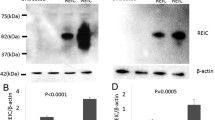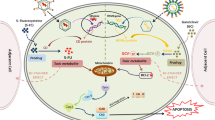Abstract
BmK CT, one of the key toxins in the venom of the scorpion, Buthus martensii Karsch, can interact specifically with glioma cells as a chloride channel blocker and inhibit the invasion and migration of those cells via MMP-2. A recombinant adenovirus, Ad-BmK CT, was constructed and characterized by in vitro and in vivo studies, using MTT cytotoxicity assay and the glioma C6/RFP (red fluorescence protein)/BALB/c allogeneic athymic nude mice model, respectively. The adenovirus-mediated expression of BmK CT displayed a high activity in suppressing rat C6 glioma cells growth and invasion thereby suggesting that this recombinant adenovirus may be a powerful method for treating glioblastoma.






Similar content being viewed by others
References
Badie B, Drazan KE, Kramar MH, Shaked A, Black KL (1995) Adenovirus-mediated p53 gene delivery inhibits 9L glioma growth in rats. Neurol Res 17:209–216
DeBin JA, Maggio JE, Strichartz GR (1993) Purification and characterization of chlorotoxin, a chloride channel ligand from the venom of the scorpion. Am J Physiol 264:C361–C369
Deshane J, Garner CC, Sontheimer H (2003) Chlorotoxin inhibits glioma cell invasion via matrix metalloproteinase-2. J Biol Chem 278:4135–4144
Fan S, Sun Z, Jiang D, Dai C, Ma Y, Zhao Z, Liu H, Wu Y, Cao Z, Li W (2010) BmKCT toxin inhibits glioma proliferation and tumor metastasis. Cancer Lett 291:158–166
Fu YJ, Yin LT, Liang AH, Zhang CF, Wang W, Chai BF, Yang JY, Fan XJ (2007) Therapeutic potential of chlorotoxin-like neurotoxin from the Chinese scorpion for human gliomas. Neurosci Lett 412:62–67
Fu YJ, An N, Chan KG, Wu YB, Zheng SH, Liang AH (2011) A model of BmK CT in inhibiting glioma cell migration via matrix metalloproteinase-2 from experimental and molecular dynamics simulation study. Biotechnol Lett 33:1309–1317
Garkavtsev I, Kozin SV, Chernova O, Xu L, Winkler F, Brown E, Barnett GH, Jain RK (2004) The candidate tumour suppressor protein ING4 regulates brain tumour growth and angiogenesis. Nature 428:328–332
King GD, Muhammad AK, Xiong W, Kroeger KM, Puntel M, Larocque D, Palmer D, Ng P, Lowenstein PR, Castro MG (2008) High-capacity adenovirus vector-mediated anti-glioma gene therapy in the presence of systemic antiadenovirus immunity. J Virol 82:4680–4684
Kurozumi K, Tamiya T, Ono Y, Otsuka S, Kambara H, Adachi Y, Ichikawa T, Hamada H, Ohmoto T (2004) Apoptosis induction with 5-fluorocytosine/cytosine deaminase gene therapy for human malignant glioma cells mediated by adenovirus. J Neurooncol 66:117–127
Mitlianga PG, Sioka C, Vartholomatos G, Goussia A, Polyzoidis K, Rao JS, Kyritsis AP (2006) p53 enhances the Delta-24 conditionally replicative adenovirus anti-glioma effect. Oncol Rep 15:149–153
Nashimoto T, Komata T, Kanzawa T, Aoki H, Endo S, Kon T, Uzuka T, Takahashi H, Kondo S, Tanaka R (2005) Mild hyperthermia plus adenoviral p53 over-expression additively inhibits the viability of human malignant glioma cells. Int J Hyperthermia 21:615–629
Olsen ML, Schade S, Lyons SA, Amaral MD, Sontheimer H (2003) Expression of voltage-gated chloride channels in human glioma cells. J Neurosci 23:5572–5582
Perez-Cruet MJ, Trask TW, Chen SH, Goodman JC, Woo SL, Grossman RG, Shine HD (1994) Adenovirus-mediated gene therapy of experimental gliomas. J Neurosci Res 39:506–511
Shen S, Khazaeli MB, Gillespie GY, Alvarez VL (2005) Radiation dosimetry of 131I-chlorotoxin for targeted radiotherapy in glioma-bearing mice. J Neurooncol 71:113–119
Sontheimer H (2003) Malignant gliomas: perverting glutamate and ion homeostasis for selective advantage. Trends Neurosci 26:543–549
Soroceanu L, Gillespie Y, Khazaeli MB, Sontheimer H (1998) Use of chlorotoxin for targeting of primary brain tumors. Cancer Res 58:4871–4879
Tyynela K, Sandmair AM, Turunen M, Vanninen R, Vainio P, Kauppinen R, Johansson R, Vapalahti M, Yla-Herttuala S (2002) Adenovirus-mediated herpes simplex virus thymidine kinase gene therapy in BT4C rat glioma model. Cancer Gene Ther 9:917–924
Veiseh M, Gabikian P, Bahrami SB, Veiseh O, Zhang M, Hackman RC, Ravanpay AC, Stroud MR, Kusuma Y, Hansen SJ, Kwok D, Munoz NM, Sze RW, Grady WM, Greenberg NM, Ellenbogen RG, Olson JM (2007) Tumor paint: a chlorotoxin:Cy5.5 bioconjugate for intraoperative visualization of cancer foci. Cancer Res 67:6882–6888
Wang WX, Ji YH (2005) Scorpion venom induces glioma cell apoptosis in vivo and inhibits glioma tumor growth in vitro. J Neurooncol 73:1–7
Wu JJ, Dai L, Lan ZD, Chi CW (2000) The gene cloning and sequencing of Bm-12, a chlorotoxin-like peptide from the scorpion Buthus martensi Karsch. Toxicon 38:661–668
Zeng XC, Li WX, Zhu SY, Peng F, Zhu ZH, Wu KL, Yiang FH (2000) Cloning and characterization of a cDNA sequence encoding the precursor of a chlorotoxin-like peptide from the Chinese scorpion Buthus martensii Karsch. Toxicon 38:1009–1014
Zhao Y, Miao J, Zhang H, Sheng W, Miao L, Xie Y, Yang J (2007) Cellular apoptosis of C6 mouse glioma cells induced by hING4 mediated by Adenovirus. China Biotechnol 27:33–39
Acknowledgments
This project is supported by grants from “National Natural Science Foundation of China (No. 31272100, 31071924)”, the “National High Technology Research and Development Program of China (863 Program, No. 2012AA020809)”, and “the Program for the Top Young Academic Leaders of Higher Learning Institutions of Shanxi”. We wish to thank Prof. Hong Tang (Institute of Biophysics, Chinese Academy of Sciences) for technical advice on the animal experiments. We will also like to thank Shuhua Zheng (University of Miami Miller School of Medicine) for his comments and grammar revision of the paper.
Author information
Authors and Affiliations
Corresponding author
Rights and permissions
About this article
Cite this article
Du, J., Fu, Y., Wang, J. et al. Adenovirus-mediated expression of BmK CT suppresses growth and invasion of rat C6 glioma cells. Biotechnol Lett 35, 861–870 (2013). https://doi.org/10.1007/s10529-013-1167-9
Received:
Accepted:
Published:
Issue Date:
DOI: https://doi.org/10.1007/s10529-013-1167-9




